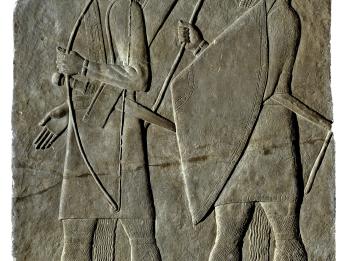A song I engraved on the tombstone (matzevet) of my master, my father, may he be remembered for the life of the world to come. The holy seed shall be its stock (matzavtah; Isaiah 6:13), is it not the excellent scholar, the pious, the humble, our greatly honorable teacher, R. Solomon Abraham the priest, may the memory of the righteous be for a blessing:
Upon the pure candelabrum
Tears shall flow like a stream
The source of insight and light
I recognize like the Torah, like a fierce lion
The Lord shone forth a light
And His presence rested upon him
The beloved of the fearsome Lord
His portion was spread out early in the year 5450 [1689].
I also engraved the following on his tombstone:
Built with turrets (Song of Songs 4:4), the image of the palace of Zion for King Solomon
To the sight of hearts, upon it was all that came to the table of King Solomon (1 Kings 5:7).
For the Almighty has dealt bitterly (Ruth 1:20); on the day of His rage He removed his understanding, and sent His anger to Solomon.
He took up a weapon in purity [see Psalms 2:12] to fight [lehilaḥem] from the year 5397 [1637], the bread [leḥem] of Solomon.
In the month of Elul it was decreed upon him, on the 27th of the month, behold is the bed of Solomon (Song of Songs 3:7).
A song I engraved on the tombstone of my relative, my flesh-and-blood, the excellent scholar, Baruch the priest, who passed away just before his wedding:
While he was yet green (Job 8:12), a fruitful vine still in his shade
Near his wedding he was over and gone [see Song of Songs 2:11].
The angels up high ask: “Why did You create him?
Why did his features last for such a short period?”
For at this time he completed the work of his soul;
Come out to greet him with a blessing [barukh] as he departs.
Another song for the same bridegroom:
May he be blessed [barukh] among the sons, and mentioned together with rabbis.
He was twenty-two years old, sown among the thistles.
He was near his joy, just before his wedding.
His features were destroyed, along with the splendor of his countenance.
Yet another song for this bridegroom:
All who are bitter and who sigh, approach his gravestone
And see a bridegroom whose glory and form were cut short;
He gave all that he had for his ransom
For he will not be fertile among the fawns.
A song I engraved on the tombstone of the excellent scholar, the pious, the humble, our greatly honored teacher, R. Isaac Siloira, may the memory of the righteous be for a blessing:
Do not be glad and rejoice, O earth, and declare: A righteous man shines from within me.
Not so; for he is sacrificing in the skies before the Lord;
He has ascended to the place hewn out for him, and his face burns like fire.
This is not his permanent residence, but only for a short while, as a guest
Until the hour of God’s will, when the sound of the shofar will blast.
A song for an honorable and modest lady:
The dear honorable daughter is now amid the dust.
Just hearing this, one trembles and shakes;
Do not glory in yourself, O land of my people, at this worthy daughter,
Equal to the greatly honored of the congregation and assembly;
Know that her soul is bound up like the pupil of the eye;
It has returned to its place, its designated spot.
All the women of the tent [see Judges 5:24] shall come out together
With her perfume among them, like the best myrrh and cassia.





